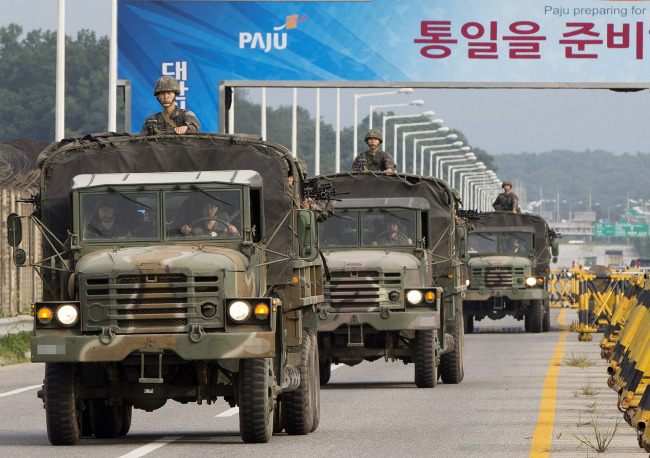South Korea and the U.S. are seeking to mobilize a B-52 strategic bomber, nuclear-powered submarine and other strategic assets on the peninsula as part of efforts to deter a potential provocation of North Korea, Seoul officials said Monday.
 |
|
Military transport vehicles carrying Army troops move past the Unification Bridge, close to the Demilitarized Zone, in Paju, Gyeonggi Province, Monday. (Yonhap) |
Uncertainties were growing across the border as the North Korean military was seen sharply building up frontline artillery forces and sending out an unprecedented number of submarines for unidentified operations since leader Kim Jong-un declared a “quasi-state of war” on Friday.
The North has also forward-deployed air cushion vehicles and 76.2-milimeter artillery guns, Seoul officials said, with frontline troops being placed in full combat readiness.
“While constantly monitoring the crisis situation on the peninsula, South Korea and the U.S. are flexibly looking into the deployment timing of U.S. strategic assets,” Defense Ministry spokesperson Kim Min-seok said at a news briefing.
“The first is to deter a possible provocation by North Korea through the alliance’s robust readiness posture, and then we respond rigorously, to the degree where it would regret, if it indeed commits a provocation,” he said.
Kim did not elaborate on details of the possible incoming weapons, but there a B-52 strategic bomber and nuclear-armed submarine are believed to have a good chance of being included.
During joint military exercises early last year, the U.S. sent B-52 and B-2 bombers and an F-22 stealth fighter over the peninsula and brought in a nuclear submarine, invoking Pyongyang’s repeated threats of an atomic war.
The allies have also deployed powerful warships, bombers and fighters including the formidable nuclear USS George Washington aircraft carrier and the F/A-18 Hornet fighter jet in a display of force against North Korea‘s major provocations.
Kim’s remarks came one day after the ministry unveiled that front-line North Korean units have placed in ready position twice as many gunners as detected Friday, and that it was being unable to locate about 50 undersea vehicles, or 70 percent of the North’s submarine fleet, which have apparently left their bases.
The move is likely to be aimed at securing the upper hand in the inter-Korean negotiations which have since Saturday been taking place at the border village of Panmunjeom while gearing up for an additional provocation in case of a breakdown of the talks, military sources said.
To better counter North Korea’s maritime threats, Washington has strengthened antisubmarine and other maritime warfare exercises with South, a U.S. Defense Department report said.
“In Northeast Asia, the department conducts several regular maritime exercises with Japan and South Korea focusing on enhancing our combined capabilities to counter provocations and manage the changing Northeast Asian security environment,” the Asia-Pacific Maritime Strategy report said.
“Though its original purpose was to counter special operations forces, the annual bilateral Key Resolve/Foal Eagle exercise with the ROK now includes amphibious operations and antisubmarine warfare in recognition of the importance of the maritime domain in defending South Korea.”
By Shin Hyon-hee (heeshin@heraldcorp.com)

